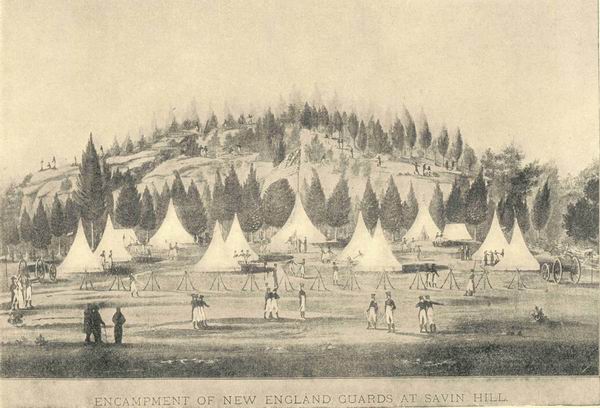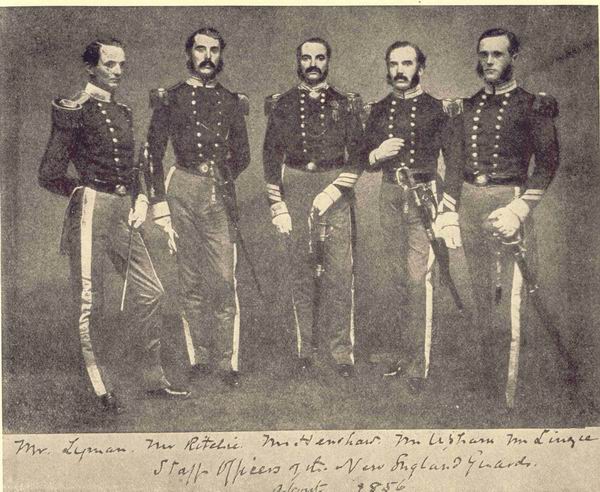|
1999-2003 (Return to Web Text-ures) |
Click Here to return to |
|
1999-2003 (Return to Web Text-ures) |
Click Here to return to |
THE NEW ENGLAND GUARDS
The New England Guards was an organization formed in the War of 1812, and after the year 1860 was usually known as the “Fourth Battalion.” As well as performing its usual State military duty it saw service in the wars of 1812 and 1861. The records of the company are preserved in the Bostonian Society, having been saved by great good luck from the fire of 1872, owing to the fact that they had been borrowed just at that time from the archives. The first recorded meeting was on September 3, 18I2, and it was then announced that the Selectmen had given one of the rooms in Faneuil Hall for the use of the Guards as an armory. The “New England Guards” was officially organized later in the month, Samuel Swett being chosen captain, George Sullivan, lieutenant, and Lemuel Blake, ensign. It was provided that a fine be levied if a member left the town for over three months, and also for failure to report within six days of his return. The first parade was on November 19, 1815, the line of march of the fifty-six men being through State Street, Cornhill, Winter and Park Streets. The motto of the company was “Our Nation’s Honour is the Bond of Union.” The records of the organization are very voluminous and very neatly kept, although there are two mistakes that are very amusing. The expression “tuck up the line of march” is used, and when referring to a candidate it is mentioned that he was “admitted a member of the corpse.” In 1814 the State legislature furnished the company with two cannons which were placed in the rooms of the Bostonian Society in 1880. They are inscribed, “Cast and mounted by order of the Board of War for the N. E. G. 1814.” On February 18, 1813, the Guards escorted Commodore Bainbridge from Long Wharf up State Street to the Exchange Coffee House, and in the autumn of the same year the company encamped near the estate of the Honk Peter C. Brooks in Medford. The record of this outing reads, “Thus having the honour to be the first military corps that has marched out of town with complete camp equipage . . . since the establishment of our Commonwealth.” This custom was carried out almost every year but was not followed by other troops. A few years later the clerk of the company was so proud of the behavior of his comrades that he inscribed on the records, “Although several apple-trees were bending under the weight of their fruit in the immediate vicinity of the encampment, not one of them was an apple lighter when we left.” The encampment at Savin Hill, shown in the accompanying cut, was in honor of Lafayette, who made it a visit, and it was therefore called the “Lafayette Campaign.” General Lafayette and the Governor of Massachusetts both tried their hand at target practice, and the Mayor and members of the City Government were also present. Seventy men were in camp here,—a large number for those days.

From a print.
Collection of Bostonian Society.
A CAMP OF MILITIA, SHOWING THE EARLY STYLE OF UNIFORMS
Another expedition of the New England Guards was to Barnstable to assist in the second centennial celebration of that town. Almost the entire company became seasick soon after passing Fort Independence but recovered in time for the procession. An oration followed, about which the company’s scribe wrote, “As all things must have an end, so the services and oration were at length concluded.” One of the toasts drunk was “The New England Guards: Cape Cod gives them to-day as friends what they are always prepared to. give their country’s enemies,—a warm reception.”
The Guards also performed escort duty during the procession to Bunker Hill in 1825 when the corner-stone of the monument was laid. Ten years later a ball was given to the Company at the Norfolk House, which was attended by “the lovely beings whom nature has ordered to be the participators of man’s joys and sorrows,” the clerk (evidently an admirer of the fair sex) also inserting, “For although it must be acknowledged that champagne has power, it must also be acknowledged that it has not the charm of the musical voice of a beautiful lady.”
In 1844 the Guards made a trip to Providence and New York and wore their bearskin caps for the first time. In their records is an account of a Rhode Island clam-bake given to them by the Light Infantry of Providence.
In August, 1856 the Hon. Robert C. Winthrop gave a brilliant ball for them at Nahant. The armory in Gray’s Building on the southern corner of Washington and Summer Streets was dedicated on October 10, 1859, speeches being made by Mayor Seaver, General B. F. Edmands and Colonel Thomas C. Amory of the Cadets.
During the war the Guards, who now were part of the Fourth Battalion, were sent to garrison Fort Independence, but there is no list of those who served then. The New England Guards Reserve — composed of men who could not go to the front —was organized at the beginning of the war to take the place of the Guards who were able to go. The Guards became a part of the 24th Massachusetts, which was recruited by Mayor Thomas G. Stevenson, whose statue is at the entrance of the Hall of Flags in the State House. In 1862 Governor Andrew presented a flag to the Guards, and several years later the company dissolved.
The following is the epitaph of the New England Guards: “The only militia organization in the country which died from patriotism, most of its members capable of bearing arms having gone into active service in defence of the Nation’s integrity.”

From a photograph.
Courtesy of J. T. Linzee.
SOME OFFICERS OF THE MILITIA IN 1856.